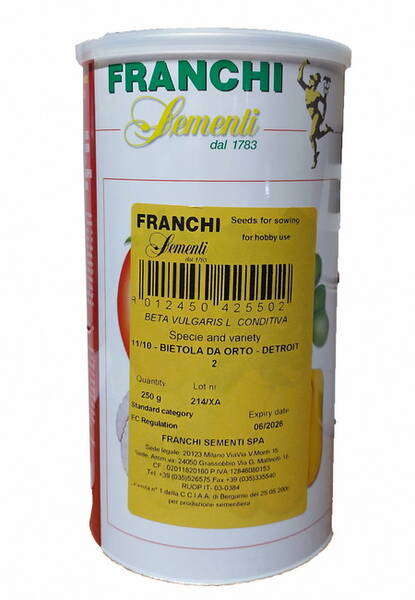Ex Tax: 15.95€
Ideal for freezing!
A mid-early variety of red beet that ripens 85-95 days after planting.
Root crops are round, very beautiful, with a smooth skin and a small rosette of leaves. The pulp is dark red, excellent structure and pleasant taste.
Root vegetables are suitable for all types of home cooking. The dark red pulp of root vegetables is especially good in borscht, beetroot, for making juices.
The good keeping quality of the root crops extends the consumption period of this beet by several months.
Seeds are sown in late April - early May, in a soil warmed up to a temperature of + 8 + 10 C, to a depth of 2-3 cm, in rows with row spacing of 25-30 cm.
Seedlings are thinned in increments of 8-10 cm.
You can also grow through seedlings: then sowing is carried out at the end of April, and the planting of hardened seedlings in open ground - in a month.
* The easiest way to disinfect seeds is to warm them up in hot water (+ 48 + 50 ° С) for 20-30 minutes.
After the procedure, they must be immediately cooled, keeping for 2-3 minutes in cold water, and dried. Before planting, seeds with a dense shell (beets, spinach, onions) or containing essential oils (parsley, carrots) are kept in water for 24 hours; seeds of cucumbers, zucchini, tomatoes, cabbage, lettuce - no more than 12 hours; the seeds of peas and beans are immersed in water first for 2 hours, then taken out and after 3 hours again placed in water for 2 hours.
Soak the seeds in a low, wide vessel. They are immersed in water at room temperature shallowly and preferably in a gauze bag.
It is important that the amount of water corresponds to the volume of the seeds being soaked.
So, for cucumbers and cabbage, there should be 2 times more water than seeds; for carrots, parsley, parsnips, lettuce, peas, beans - an equal amount; for tomato, onion - 20-30% less than seeds. Periodically, the seed bags are removed from the water to enrich them with oxygen. The water is changed every 4-5 hours.
For soaking seeds, not only water is used, but also weak solutions of microelements: boron and molybdenum.
Sprouted seeds are sown in warm weather and in moist soil. If the weather is bad, the seeds are placed in the refrigerator or germinated until single white roots appear on damp filter paper.
* Beets are responsive to salt water irrigation. Prefers sandy and loamy soils, moist and fertile. The beds should receive enough light and warmth.
Crops must be thinned out.
The first thinning is done 5-10 days after germination, no later than the moment the second pair of true leaves is formed. There should be a distance of 2-4 cm between plants in a row.
The second time the beets are thinned out when they have 4-5 true leaves, leaving a distance of 4-6 cm between the plants.
The third thinning should be carried out until mid-August, leaving the plants in a row at a distance of 5-8 cm.
Beets are very responsive to feeding with a solution of bird droppings, cow dung and mineral fertilizers.
Therefore, we recommend this top dressing: dilute a half-liter can of mullein, a tablespoon of nitrofoska and half a teaspoon of boric acid in 10 liters of water. For 1 sq. m consume 3-4 liters of solution.
With good care, the first roots are usually harvested in the second half of July. Final cleaning should be completed in the second half of September.












